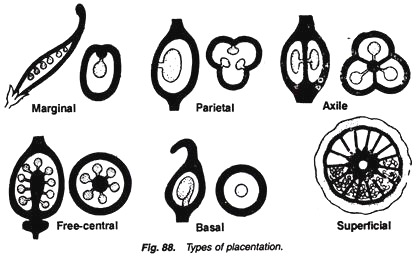ADVERTISEMENTS:
The following points highlight the top six types of placentation in a plant. The types are: 1. Marginal 2. Parietal 3. Axile 4. Free-central 5. Superficial or Laminar 6. Basal.
Placentation in Plants: Type # 1. Marginal:
ADVERTISEMENTS:
The ovules develop in rows near the margin on the placenta formed along the ventral suture. It occurs in monocarpellary and unilocular ovary, e.g., Leguminosae.
Placentation in Plants: Type # 2. Parietal:
The placenta is formed by the swelling up of cohering margins, and on the latter develop the ovules in rows. It occurs in bicarpellary or multicarpellary but unilocular ovary, e.g., Papaveraceae.
Placentation in Plants: Type # 3. Axile:
ADVERTISEMENTS:
Here, the placentae develop from the central axis which correspond to the confluent margins of carpels. It occurs in bi-to multilocular ovary, e.g., Solanaceae, Malvaceae.
Placentation in Plants: Type # 4. Free-central:
Here, the placenta develop in the centre of the ovary as a prolongation of floral axis and the ovules are attached on this axis. It occurs in multicarpellary but unilocular ovary, e.g., Primulaceae.
Placentation in Plants: Type # 5. Superficial or Laminar:
Here, the ovules develop over the entire inner surface of the carpels. It occurs in multicarpellary ovary, e.g., Nymphaea.
Placentation in Plants: Type # 6. Basal:
The placenta develops directly on the thalamus and bears a single ovule at the base of the unilocular ovary, e.g., Compositae.

